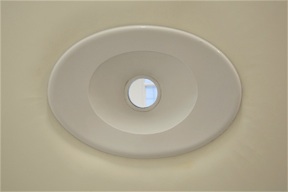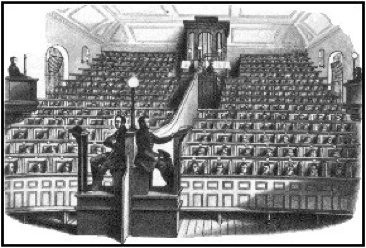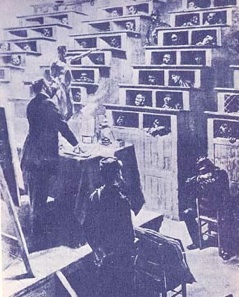CELL
Degree show installation by Crispin Chetwynd

CELL (AG23)
This installation divides the studio, gallery space in two, the apertures for viewing front and back, ideas of in or out, viewing or viewed, the ready made, the hand crafted, soft and hard elements that hold weight, recreating a sense of the past and re-establishing it in the present.




PENTAGON 5 & 6 (Parade Ground)
Reinstating boundary lines of the Millbank penitentiary, showing the historic layering of architectural structures relating to what is now chelsea collage of art, the work interacts, cuts across and connects to other work shown on the parade ground.
Mixing ideas of control through the prison, the school, the gallery, the hospital and the army which all have similar systems designed for control through processes of prescribed routes and the monitoring of them.


The SAMs can be designated by the U.S. Attorney General for up to a year and renewed continually thereafter resulting in perpetual solitary confinement, considered a form of torture under international law.
English Philosopher and social theorist, Jeremy Bentham Panopticon.
“Morals reformed, health preserved,
industry invigorated, instruction diffused, public burthens lightened economy
seated, as it were, upon a rock, all by a simple idea in architecture” (Jeremy
Bentham)
The Panopticon is a type of prison
designed by English philosopher Jeremy
Bentham in the late eighteenth century.
The concept of the design is to allow an
observer to observe (-opticon) all (pan)prisoners without the prisoner being able to tell if they are being observed or not , in his own words, Bentham described the Panopticon as “ a new mode of obtaining power of mind over mind in a
quantity hitherto without example.”

Millbank Prison was a large prison built beside the river Thames in Millbank, Pimlico, London. Work started in 1812 and it opened in 1821. It was designed by William Williams in 1812 in accordance with the utilitarian principles laid down by Jeremy Bentham,. It adopted the “Separate model” of solitary confinement and hard work designed to
promote reflection and reform. The external walls form an irregular octagon, and enclose no less than eighteen acres of ground. This vast space comprehends seven distinct, though conjoined, masses of building, the centre being a regular Hexagon, and the others branching from its respective sides. By this means the governor or overseer may, at all times, from the windows in the central part, have time power of over looking division of the Prison.
Solitary the segregation of space in the
institution
In 1821 Millbank Penitentiary had been completed on lines suggested by Jeremy Bentham. By the time Millbank was opened, plans for a number of other prisons had been approved. In the 1830s

arranged in tiers and in separate blocks radiating from a central hub like the spokes of a wheel. Pentonville had 520 small cells, each measuring thirteen feet by seven. Each cell had a small window on the outside wall and a door opening on to the narrow landings in the galleries. The cells were well ventilated and had the luxuries of a water-closet, though water-closets were later replaced by the communal, evil-smelling recesses because they were getting blocked constantly and their pipes were used as a means of communication. The prisoners were forbidden to talk to each other and were stripped of their identity. They had to wear a cap called a 'peak' that covered each man's face when they were together and numbers not names were used. When they took exercise the prisoners walked in silent rows, holding a rope that had knots tied man apart from the next. In chapel, which they had to attend every day, they sat in little cubicles, their heads visible to the warder on duty but hidden from each other. Lincoln Prison's chapel is built to the same plan and is the only existing example of this type of chapel left in England. In chapel, the men sang loudly since this was the only time they were allowed to use their voices. They took the opportunity to talk to the man in the next cubicle while everyone else sang the hymns.

Discipline and punish The tension between the visible and the knowable suggested by Foucault’s
metaphor finds its most explicit manifestation in the social ordering and separation of public and private spaces. In other words, the spatial demarcations in and with which we live, work, and
engage art are themselves political divides. We are viewers of art in a museum. Yet, even more specifically, we are seen by others as viewers in that museum, and not as the artist or the artwork. As such, we experience directly, if implicitly, the effect of the ordering that has been and continues to be the politicized space of the museum. The revolution of art that we associate with, among other
things, Marcel Duchamp’s infamous Fountain (1917) failed to destroy the art museum. The museum survives. Yet the digital transformation to which Helft’s article alludes promises the imminent material destruction of the museum—and, with the destruction of the museum, the paradigmatic
(material) site of aesthetic refuge and reflection.
My tom tom sat nav alerts me to where speed cameras are I adjust my speed accordingly , though it makes me feel I am in control and am able to beet the system the system is still in control in this perception of power of the tom tom. The Internet and the panopticon make significantly similar assumptions about the creation of the subject within discourse. Both panopticism and the Internet construct space with a special attention to the subject's internalizing a particular model of space, and a particular notion of how people are distributed throughout space in relation to one another, and with a special attention to the defining of the individual through the space she occupies. Further, both are intensely interested in the construction and distribution of authority over and within the subject. Surveillance society as a top-down phenomenon in which an otherwise scarcely visible oligarchy utilizes new technology as a tool of social surveillance They understand panoptic society to be a sort of Orwellian 1984 or Kafkaesque Castle in which power is invested in the powerful if invisible. The aim, then, of the neo-Foucauldian critic is to bring the powerful to light by revealing how she uses the technology for surveillance purposes. Such critics are interested in the way that society constitutes its constituent members as either prisoners or jailers, not the way that society itself is in fact a prison house in which surveillance is distributed in a manner that makes us
our own prisoners
“The panopticon does not use information just to know us; it also deploys information to create us, to constitute us as compliant workers and consumers”
“If it is panoptic, the Internet must serve the same panoptic/enlightenment function of social control through a physical control of the body in space and a rhetorical control of the definition of subjectivity that other panoptic institutions do”

masses as a spectacle.[8] But the rise in European population -- and its geographic mobility -- in the
seventeenth and eighteenth centuries made feudal and monarchical models of social control outmoded. For the beginning of the enlightenment, the practice of authority is defined as procuring for a small number, or even for a single individual, the instantaneous view of a great multitude" (D&P, 216). Spectacle is replaced by surveillance within the prison-panopticon. Unlike the medieval object of punishment, the body of the prisoner of the panopticon is not tortured; it is simply separated -- and thus alienated -- from other prisoners, and watched. This attention to the body of the prisoner is total: It implies an interest in and effect on all the movements of the prisoner. Not knowing whether or when they are on view, prisoners ultimately internalize the notion of a surveyor. This prison panopticon serves as Foucault's central metaphor for the rise of a society in which all institutions are disciplinary in both senses of the term. First, they represent a body of knowledge. Second, this disciplinary knowledge is always coercive, enforcing discipline --particular modes of behaviour and belief -- on the individual. Discourse plays an important role in this social
coercion.
Disciplinary knowledge is articulated through its own
proprietary language

define or to think anything without the languages of the limited number of discourses available
through a large but finite number of social institutions. Discourses define subjectivity. Finally,
because the notion of a central surveyor is a fiction, and so authority is internalized by each
individual surveying herself, panoptic society works by employing institutions to distribute power throughout society. This is not to say that power is democratically or equally distributed, or distributed for the purpose of democratizing society. Such distribution is simply themost efficient way to maintain a stably quiescent and productive society, by making certain that everyone can
potentially be surveyor or surveyed. In brief, Foucault thinks that the underside of the enlightenment that we inherited from the seventeenth and eighteenth centuries is the desire to control increasingly large numbers of people in a manner that monarchies were not able to accomplish: Both by distributing self regulating bodies regularly through space and, as a consequence, by having people police themselves because they believe they are being surveyed. The machine has repeatedly been a metaphor for the operation of culture and humanity in the twentieth century elsewhere than in Haraway, from Henri Bergson's essay on Laughter, Le rire:essai sur la signification du comique, Paris: Presses universitaires de France, 1989, to Gilles Delueze's and Felix Guattari's Anti-Oedipus: Capitalism and Schizophrenia, trans. Robert Hurley, Minneapolis, MN: University of Minnesota Press, 1985. New technologies, however, have not been so widely deployed. Jürgen Habermas, "Modernity -- An Incomplete Project," and Fredric Jameson, "Postmodernism and Consumer Society," both in The Anti-Aesthetic: Essay son Postmodern Culture, ed. Hal Foster, Seattle, WA: Bay Press, 1983, pp. 3-15 and 111-25, respectively. Though more persuasive writers like Lawrence Lessig suggest that legislation and legal decisions concerning the Internet support Jameson
Society Politics, ideology
The fear of ghosts not because they exist but precisly because they don’t exist Just like ghosts, the god of the panopticon also has effects only as a fiction. If the “hidden” god were to reveal himself in
the panopticon , if the apparent omnipresence of God in the eyes of the prisoner were replaced by the real presence of the inspector It is through the nonexistence of God that he sustains the universe of the panopticon
Reality itself is constructed like a fiction